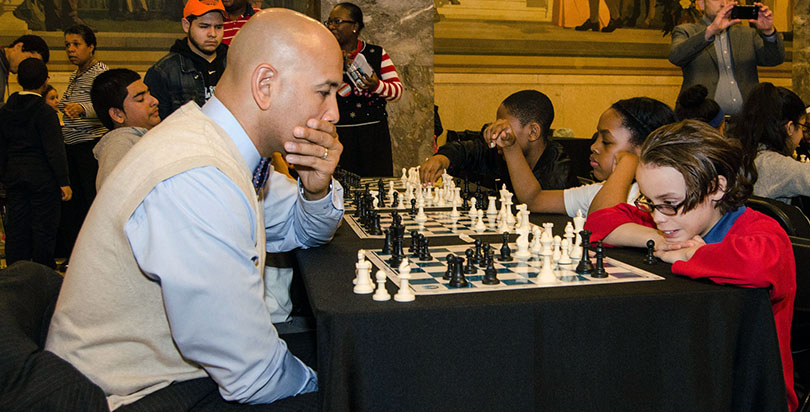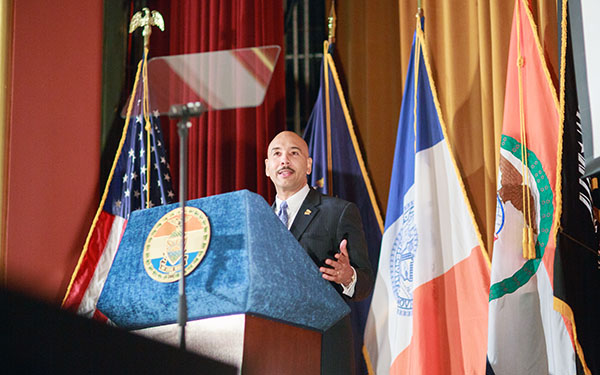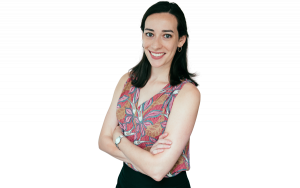Ruben Diaz, Jr., the Up-and-Coming Bronx Leader Who Just Might Be NYC’s Next ‘Education Mayor’

Bronx, New York
When his career as Bronx Borough President is all said and done, Ruben Diaz, Jr., envisions himself, perhaps, standing at the front of a classroom, nurturing young minds.
On the other hand, the 42-year-old rising star in New York political circles might just have his eye on City Hall.
The widely discussed possibility of a Diaz, Jr. bid to become New York City’s first Hispanic mayor gained some traction after his Feb. 18 State of the Borough address, in which he touted his efforts over the last seven years to polish the image of the city’s poorest borough and expand opportunities for the Bronx’s 1.4 million residents.
Some of the highlights of his tenure since 2009, as noted in his speech: 23,000 new housing units, an invigorated workforce, reduced crime, and partnerships with the technology sector, including the “Code/Bronx” initiative launched in late 2015, which is aimed at creating computer science programs in every Bronx school.
He’s pitched ambitious proposals to rebuild the Bronx’s historic Orchard Beach, off the Long Island Sound, and develop a platform at three railyard sites to accommodate new affordable housing, retail and an expansion of Lehman College. If he has his way, the state Legislature will approve a plan for four new Metro-North stations spanning the borough.
Diaz also used the speech to distinguish how his approach diverges from his fellow Democrat, Mayor Bill de Blasio, on key issues like education.
In an interview the next day, Diaz told The Seventy Four that he considers it his job to help transform the way Bronx residents think of themselves and their borough, not to mention its reputation to those who live outside its borders. Education is at the core of that effort, he said.
“We’re trying to create jobs and we are; we’re creating housing, we’re fixing our parks, we’re trying to reduce crime,” he said in the interview. “All of this is for the future of the Bronx. And you can’t have people benefit from that unless our students are educated. And unfortunately with all the things that you heard me brag about in my speech, and all the things that I go around and say, all the wonderful work … I can’t do that in two areas — I can’t do that in health and I can’t do that in education. Not yet. And it’s frustrating.”
The reason, according to Diaz: “I just think that there hasn’t been that level of priority yet at different levels of government to really zone in in areas like the Bronx, at least academically. And that’s always an uphill battle. It always has been.”


Bronx Borough President Ruben Diaz Jr. delivers his seventh annual State of the Borough address Feb. 18 at Cardinal Hayes High School. (Photo courtesy Victor Chu) Above photo: Diaz plays chess with Ivan Hernandez, a sixth grader at M.S. 390, during a Chess Challenge on Dec. 15, 2015 at Veterans Memorial Hall at the Bronx County Building.
The Bronx has 239,100 students, mostly Hispanic and black, who make up what is by far the poorest student population in any of the five boroughs, NYC Department of Education data shows. Sixteen percent of Bronx students are English Language Learners, the highest percent of any borough, while 21 percent have disabilities, the second-highest percent behind Staten Island.
Bronx students’ performance on state math and English Language Arts tests also set them apart from their peers around the city. In 2013 through 2015, just 12.8 percent of third- through eighth-graders who took the tests scored “proficient” or higher.
Increasing the number of children from the Bronx who enter the city’s Gifted and Talented programs — which have been plagued for years by racial and socioeconomic disparity — is one of Diaz’s major initiatives. Three-quarters of students in the program are Asian or white, according to data the Department of Education was forced to release last year under a new city law.
In the Bronx, 87 pre-kindergarten students in District 7, the South Bronx, were tested for entry into the city Gifted and Talented program in 2015; only six qualified — and none were placed in a class, according to Diaz’s office.
Department of Education spokesman Harry Hartfield disputed that, saying “every student in District 7 who qualified and applied was offered a seat in a G&T program.”
Factors the department considers when deciding whether to offer a class include demand in a geographic area, whether it’s sustainable long term, and the number of qualifying students — there’s no set minimum needed to start a class, Hartfield said.
The numbers of Bronx kindergartners who took the Gifted and Talented test rose 13.6 percent from 2013-14 to 2014-15, according to the department. Hartfield added that 83 percent of the 193 Bronx kindergarteners who applied for the program (after passing the initial qualification test) received an offer for placement in a G&T class last school year.
Diaz’s office has hosted forums to encourage parents to get their children tested. He urged city education officials to test every child who enters a public pre-kindergarten program.
“Together, we raised awareness and increased the number of students who took tests for these programs in the Bronx this year,” Diaz said in his speech. “We did not wait for the city to act.”
The theme of urgency, and the need to deftly move around city bureaucracy to get things done often punctuates Diaz’s conversation — borough presidents do not have policy-making authority and the last one to be elected mayor was David Dinkins in 1989, the city’s first black mayor and former Manhattan borough president.
In an interview, Diaz stressed that he and his staff, including Director of Education & Youth Monica Major, have affected change with the tools and resources available to them — and those are not insubstantial.
Since 2009, Diaz has awarded $35.2 million in capital funds, which is allotted to the borough president’s office by the city, to schools throughout the Bronx. The money has gone toward purchasing SmartBoards and computers, installing air conditioners, and renovating playgrounds, cafeterias and auditoriums.
Some $20 million of that total has been spent on technology as Diaz works to bolster a burgeoning technology sector in the Bronx, which he hopes will one day soon be fed by a pipeline of local students.
In a partnership with the nonprofit Code/Interactive, Diaz’s office launched the Code/Bronx initiative in December with the goal of starting a computer science program at every school in the borough — whether it’s P.S. 81 in suburban, well-to-do Riverdale or Junior High School 145 Arturo Toscanini, in the South Bronx, one of the struggling “Renewal” schools targeted for intervention by the Department of Education.
“We’ve mastered downloading the app. I want our students to be the coders, to be the ones that create the apps, not just purchase the apps,” Diaz said in the interview. “We wish that the city of New York would help us augment these efforts.”
The de Blasio administration recently announced plans to spend $81 million over 10 years to train and place as many as 5,000 educators in city schools to teach computer science. It’s not clear how many of them would go to the Bronx.
Meanwhile, one of de Blasio’s signature initiatives, the school turnaround effort known as the Renewal Schools program, continues. The administration has dedicated some $400 million to bolster the lowest-performing schools in the city, including 30 in the Bronx — about a third of the 94 schools in the program. The funding goes toward leadership training, extending the school day and expanding community partnerships in an effort to boost enrollment and student performance and combat poverty.
Diaz, for his part, called the Renewal program “a good start,” but said he would wait until the first student cohort could be properly evaluated to offer a full assessment. (The 74: De Blasio Wants to be the ‘Education Mayor’ but Leaves Too Many Failure Factories Still in Business)
He made clear, however, with a wink and a nod to a friendly audience during his speech at Cardinal Hayes High School (one of his son’s alma mater), that he’s a strong supporter of mayoral control of city schools.
“Mayoral control means greater accountability around the public education system, and that accountability should be available to this mayor and all future mayors, whoever they might be,” Diaz said, drawing applause.
Mayoral control of schools is a sore subject for de Blasio, who initially sought and was denied a permanent extension last year by Gov. Andrew Cuomo and the state Legislature; instead, lawmakers granted a one-year extension, through June, and will soon consider the matter again. (The 74: Campbell Brown: Will Farina’s Failures Cost de Blasio Control of NYC’s Schools?)
Though Diaz declined to comment directly about a potential a mayoral run, he’s dropped hints that his political aspirations extend beyond the Bronx. He told NY1 in a Feb. 18 interview that, “I would have another term if the people of the Bronx would have me, but should the opportunity present itself where I can serve in another capacity and do not only for the people of the Bronx and beyond, that’s something that we would seriously consider.”
The underlying question could be one of timing: Whether Diaz might wage an attack on de Blasio as soon as the 2017 mayoral race or wait to run until 2021, after completing his presumptive third term as borough president. A factor in his potential bid is how much support he could win from Latinos and blacks, who collectively make up more than half of the city’s residents; Latinos account for 28.6 percent and blacks 25.5 percent, according to census data.
***
A lifelong Bronx resident, Diaz Jr. is one of three children of the Rev. Ruben Diaz Sr., the New York state senator, and Hilda Vega. Diaz Sr. is the outspoken, socially conservative Puerto Rican-born patriarch of a family that has left its imprint in several public spheres — Diaz’s siblings are Damaris Diaz, a retired sergeant in the New York City Police Department; and Samuel Diaz, supervisor for the New York City Housing Authority.
Diaz Jr. lives in the Soundview section of the Bronx with his wife, Hilda Gerena Diaz, and their two sons, Ruben Diaz III and Ryan Isaiah Diaz.
He attended P.S. 5 and P.S. 31, a city landmark known as “Castle on the Concourse” that was left to decay and later demolished to make way for new development. The city has a Request for Proposals out but hasn’t yet awarded a bid, Diaz’s office said.
Diaz, Jr. graduated from New York City public schools, attended LaGuardia Community College and graduated from Lehman College in the Bronx with a degree in political theory.
Diaz points to his own experience in a gifted class in District 7, in the South Bronx, still one of the city’s lowest-performing school districts, when talking about the need to expand opportunities for today’s children.
“The things that I’ve learned, the doors that were opened for me mentally, the influence that I’ve received over the years from educators, is part of my makeup and I’m a strong believer in that,” he said.
Diaz began his political career at age 23 as a New York state assemblyman representing the Bronx; he was a member of the education committee during the 12 years he spent in the Legislature.
Diaz’s term from 1997 to 2009 covered the very beginnings of New York state’s implementation of the Common Core. The standards are now being reviewed by a task force appointed by Gov. Andrew Cuomo.
“We weren’t prepared for its rollout,” he said. “The teachers didn’t have the necessary materials in time. We were saying all along here in the city of New York that Common Core needed more time to be thought out.”
Reflecting on his career in Albany, Diaz said he would have done more to support state funding for charter schools, specifically for capital improvements to ease space constraints for charters opening in New York City. State law permits charters to use state money for operational costs, including leases, but not for construction.
Diaz hasn’t hesitated to trumpet his support for charter schools — at a rally last fall, he joined the advocacy group Families for Excellent schools to publicly pressure de Blasio to be more inclusive of charter schools.
In his State of the Borough speech, Diaz highlighted P.S. 55 and Success Academy Bronx 2, which share a building on St. Paul’s Place in what he called a “peaceful coexistence.” Diaz’s office has directed $1 million in capital funds for the renovation of a playground, athletic fields and green space shared by the two schools. A grand opening is planned in June.
“As long as charter schools are successful and it creates a viable alternative to some parents, then we should continue to support them,” Diaz said in the interview.
But, perhaps recognizing the need to maintain open lines of communication with stakeholders on all sides of the debate, Diaz, in the interview, seemed almost to retreat from his rallying call of five months ago. He cautioned that adults must “lower the temperature” of the rhetoric around charter schools.
“The vitriol has gotten out of hand,” he said.
“You can be pro-charter school without being anti-traditional public school and vice versa,” he added. “If you want to support your traditional public school — no one has done that more than I have — you don’t have to do that by taking shots against the charter schools. It’s about all of our kids.”
Not all Diaz’s constituents support his stance on charter schools.
Retired teacher Violet Smith, who lives on City Island and taught special education in the Bronx for 20 years, was in the audience at Diaz’s speech. She cheered his efforts to combat homelessness and expand housing, but said in an interview afterward that she can’t agree that charter schools are a viable alternative for students who’ve long languished in crumbling, underfunded district schools.
“There’s such disparity,” Smith said, recalling how at one co-located school she’d been to, charter classrooms were filled with new desks and supplies while down the hall, a district school classroom was sorely neglected.
Smith also worries that charter schools don’t equitably serve students with disabilities. Research shows New York City charter schools do serve a lower percentage of students with disabilities and English Language Learners than do traditional schools, though they are increasingly enrolling more of these students. (The 74: Opinion: There Are More High-Needs Students In NYC Charters Than You Think)
Stephen Ritz, a Bronx teacher for three decades who runs a health and wellness center at P.S. 55, is an ardent fan of the borough president. He believes Diaz is one of the few leaders who has the diverse network of relationships that could allow him to steer the traditional school system and the charter sector toward a healing process.
“This is the first borough president that people know by name,” Ritz said. “Kids want to play basketball with him … he’s in parks, he’s in schools, he’s in senior centers.”
“I think there’s a groundswell of support for him in the borough,” Ritz added. “How that will translate across the city remains to be seen. But I think he transmits a kind of honesty and commitment to all that would be refreshing.”
Get stories like these delivered straight to your inbox. Sign up for The 74 Newsletter

;)
